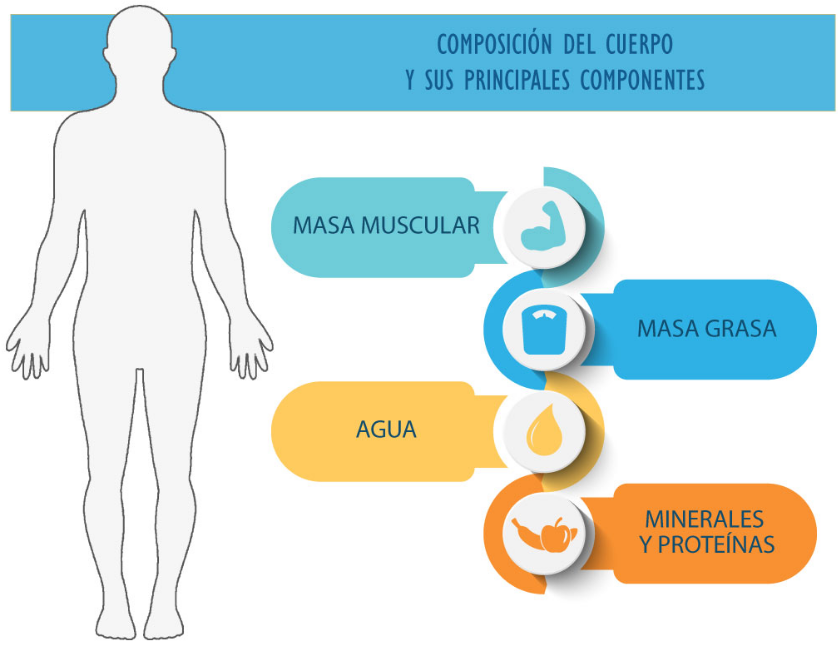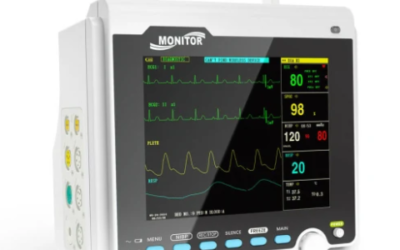Bioimpedance is a non-invasive and accurate technique used in clinical engineering to assess body composition. In this article, we will explore in detail this advanced technology and its role in hospital management and health monitoring.
Índice del Articulo
What is bioimpedance?
Bioimpedance is a technique that measures the resistance of the human body to the passage of a low-frequency electrical current. This resistance is called impedance and varies depending on the composition of the body’s tissues and fluids. Bioimpedance is commonly used in the medical and health field to obtain information about body composition, hydration status, and other physiological characteristics.
The basic principle of bioimpedance is based on the fact that different tissues in the body have different levels of electrical conductivity. Water, present in muscles and other tissues, is a good electrical conductor, while fat and bones have a lower conductivity. Therefore, by sending an electrical current through the body and measuring the electrical response, it is possible to obtain information about the amount of water, muscle, and fat in the body.
There are two main approaches to bioimpedance:
Single Frequency Bioimpedance (BIA):
In this approach, an electrical current of a single frequency is used to measure impedance. Both resistance (real part of impedance) and reactance (imaginary part of impedance) are measured. BIA is commonly used to estimate body composition.
Multiple Frequency Bioimpedance (MFBIA):
This approach involves using multiple frequencies of electrical current to obtain more detailed measurements. By using different frequencies, more accurate estimates of body composition and hydration status can be obtained.

Applications of bioimpedance in clinical engineering:
Bioimpedance has various applications in clinical engineering, where it is used to assess and monitor different physiological and clinical parameters. Below are some of the specific applications of bioimpedance in this field:
Body Composition:
The application of body composition measurement includes the assessment of body fat percentage, lean mass, and other components. In Clinical Engineering, it focuses on the implementation and maintenance of bioimpedance equipment, used to accurately measure body composition. This involves tasks such as calibration and quality assurance of the results obtained.
Hydration Monitoring:
The application of hydration monitoring involves assessing the patient’s hydration status. In the field of Clinical Engineering, it involves the implementation and maintenance of bioimpedance devices that monitor the amount of water in the body. This approach contributes to clinical and nutritional management, ensuring effective monitoring of the patient’s hydration status.
Edema Detection:
The application of edema detection focuses on identifying abnormal fluid accumulation in tissues. In the field of Clinical Engineering, it involves the development and management of bioimpedance technologies to detect changes in impedance associated with edema. This approach contributes to clinical monitoring, allowing early identification of conditions related to fluid retention in tissues.
Cardiovascular Assessment:
Cardiovascular assessment is applied to assess parameters related to cardiovascular health. In Clinical Engineering, this process involves the implementation and maintenance of bioimpedance devices intended to assess cardiovascular parameters, such as cardiac impedance. These devices contribute to clinical monitoring, providing valuable information on the health of the patient’s cardiovascular system.
Nutritional Monitoring:
Cardiovascular assessment is applied to assess parameters related to cardiovascular health. In Clinical Engineering, this process involves the implementation and maintenance of bioimpedance devices intended to assess cardiovascular parameters, such as cardiac impedance. These devices contribute to clinical monitoring, providing valuable information on the health of the patient’s cardiovascular system.
Rehabilitation and Physiotherapy:
The application in rehabilitation and physiotherapy involves the assessment of muscle mass and the monitoring of the rehabilitation process. In the field of Clinical Engineering, the focus is on the development and management of bioimpedance devices used in rehabilitation environments. These devices are used to assess changes in body composition and monitor the effectiveness of therapies, contributing to the recovery and treatment process.
Bioimpedance in Specific Therapies:
The application of bioimpedance in specific therapies, such as electrical stimulation or electroshock therapy, involves its integration into particular therapeutic processes. In the field of Clinical Engineering, it focuses on ensuring the precision and safety of the equipment used in therapies that incorporate bioimpedance, guaranteeing its correct operation and benefit for patients.
Continuous Monitoring of Physiological Parameters:
The continuous monitoring of physiological parameters through bioimpedance involves the use of this technology for the constant monitoring of changes in body composition and hydration status. In the field of Clinical Engineering, it focuses on the development and maintenance of continuous monitoring systems. This involves guaranteeing the precision and reliability of measurements, ensuring a constant and accurate assessment of relevant physiological parameters.
Brain-Computer Interface (BCI):
The brain-computer interface (BCI) involves the implementation of bioimpedance in BCI systems to allow direct communication between the brain and external devices. In the field of Clinical Engineering, the focus is on the development of BCI technologies that incorporate bioimpedance, facilitating specific applications in people with motor disabilities. This opens up new possibilities to improve communication and quality of life for this group of patients.
Clinical Research:
In the field of clinical research, the application of bioimpedance involves its use in clinical studies to obtain data on body composition, hydration and other physiological parameters. In Clinical Engineering, the focus is on supporting the implementation of bioimpedance equipment in clinical research projects, ensuring the quality and reliability of the data obtained in such studies.
Clinical engineering plays a fundamental role in the implementation and maintenance of bioimpedance technologies, guaranteeing their precision, safety and functionality in diverse clinical environments.

Advantages of using bioimpedance:
Bioimpedance offers several significant advantages in the healthcare and clinical research arena due to its ability to provide rapid, noninvasive information on various physiological parameters. Here are some of the key advantages of using bioimpedance:
Noninvasive:
Bioimpedance measurement is performed without the need for invasive procedures. It requires no needles or surgical interventions, which improves patient comfort and reduces the risk of infections.
Fast and Easy:
Bioimpedance measurements are quick to perform and do not require extensive preparation. They can be easily integrated into clinical assessment protocols and provide real-time results.
Continuous Monitoring:
Bioimpedance allows for continuous monitoring of physiological parameters such as body composition and hydration status. This is especially valuable for long-term follow-up and early detection of changes.
Multiple Applications:
Bioimpedance can be used to assess body composition, hydration status, cardiovascular health, rehabilitation, and more. Its versatility makes it a valuable tool in a variety of clinical settings.
Suitable for Diverse Populations:
Bioimpedance is applicable to diverse populations, from pediatric patients to older adults. It is an adaptable tool that can be used in different healthcare settings.
No Ionizing Radiation:
Unlike some imaging techniques, bioimpedance does not use ionizing radiation, making it safe for repeated use and in sensitive populations, such as pregnant women or children.
Body Composition Assessment:
Provides a rapid, noninvasive estimate of body composition, including body fat percentage, lean mass, and other components. This is valuable in clinical and sports settings.
Early Detection of Physiological Changes:
Facilitates early detection of changes in hydration, body composition, and other parameters, which can be crucial for intervention or adjustment of treatments.
Implementation in Wearable Devices:
It can be integrated into wearable devices and remote monitoring devices, allowing measurements outside the clinical setting and improving accessibility to healthcare.
Adaptable to Various Technologies:
It can be integrated with various technologies, such as flexible, textile or implantable electrodes, allowing its use in a variety of applications and environments.
Hydration Assessment:
Bioimpedance is particularly useful in assessing hydration status, being sensitive to changes in water content in the body.
Lower Cost Compared to Some Alternatives:
Compared to certain more expensive imaging techniques, bioimpedance can offer a more accessible alternative to assess body composition and other parameters.
Bioimpedance, by combining precision, non-invasiveness and versatility, has become a valuable tool in healthcare and clinical research, contributing to a more comprehensive assessment and continuous monitoring of health.

Technological advances in bioimpedance:
In recent years, there have been significant technological advances in the field of bioimpedance, improving the accuracy, comfort, and versatility of measurements. Some of the most notable technological advances include:
Multifrequency Bioimpedance (MFBIA):
Multifrequency bioimpedance (MFBIA) is distinguished by using multiple frequencies of electrical current to obtain more detailed and accurate measurements of body composition. This approach offers benefits by providing greater accuracy in estimating body composition, by considering the variability in electrical conductivity of different tissues.
Flexible and Textile Electrodes:
The integration of flexible and textile electrodes is characterized by the incorporation of these elements into clothing or wearable devices. This practice offers benefits such as improved patient comfort, the possibility of continuous measurements, and ease of integration into wearable devices, facilitating remote monitoring of various parameters.
Wireless Sensors:
Wireless sensors are characterized by using wireless technology to transmit data from the electrodes to the measurement system. This approach offers benefits such as increased mobility and comfort for the patient by eliminating cables, facilitating remote and continuous monitoring of various biomedical parameters.
Segmental Bioimpedance:
Segmental bioimpedance is distinguished by the assessment of body composition in specific segments of the body. This approach offers benefits by providing more detailed information on the distribution of lean and fat mass in different body regions, allowing for more accurate analysis of health and body composition.
Dry and Gel-Free Electrodes:
The distinctive feature of dry and gel-free electrodes is the elimination of the use of conductive gel. This approach provides significant benefits such as greater ease of use, less mess, and less need for preparation, which improves the patient experience during its application.
Bioimpedance in Portable Devices:
Bioimpedance in portable devices is characterized by the integration of this technology in portable and wearable devices. This integration offers benefits by facilitating continuous monitoring outside the clinical environment, providing real-time data on the user’s health. This allows for more convenient and accessible monitoring of various biomedical parameters.
Nanotechnology in Bioimpedance:
The application of nanotechnology in bioimpedance is characterized by the use of nanomaterials to improve the electrical properties of electrodes. This practice brings benefits such as improved sensitivity of measurements and reduced electrode size, allowing for more accurate and less intrusive measurements in various biomedical applications.
Implantable Biosensors:
Implantable biosensors are characterized by the integration of bioimpedance into implantable devices, allowing for continuous monitoring of physiological parameters. This integration offers benefits by providing a constant source of data for personalized healthcare and effective monitoring of chronic conditions, thus contributing to improved management and treatment of patient health.
Brain-Computer Interface (BCI) with Bioimpedance:
Brain-computer interface (BCI) with bioimpedance is characterized by the incorporation of bioimpedance into BCI systems, with the aim of improving direct communication between the brain and external devices. This integration offers benefits by facilitating applications in people with motor disabilities, improving the accuracy and effectiveness of brain-machine interfaces. This opens up new possibilities for more effective communication and a higher quality of life in individuals with motor limitations.
Integration with Artificial Intelligence (AI):
Integration with artificial intelligence (AI) in the context of bioimpedance is characterized by the use of AI algorithms to analyze and interpret the data generated by this technology. This practice offers benefits by improving the accuracy of measurements and the ability to identify complex patterns in large data sets. This improvement in analysis facilitates more accurate diagnoses and recommendations, contributing to more informed clinical decision-making.
These technological advances in bioimpedance are transforming the way physiological measurements are made and are opening up new possibilities in terms of clinical and research applications. The combination of bioimpedance technology with other disciplines, such as nanotechnology and artificial intelligence, promises to continue improving the accuracy and utility of this technique in the field of healthcare.

Frequently asked questions about bioimpedance:
What is bioimpedance?
Bioimpedance is a technique that measures the resistance of the human body to the passage of a low-frequency electric current. It is used to assess body composition and other physiological properties.
How does bioimpedance work in measuring body composition?
Electrical current flows through the body, encountering resistance in different tissues. Bioimpedance measures this resistance and calculates the amount of water, fat and lean mass in the body.
What are the common applications of bioimpedance in the clinical field?
Bioimpedance is used to assess body composition, monitor hydration status, diagnose metabolic disorders, and assess cardiac function, among other clinical applications.
Is bioimpedance safe?
Yes, bioimpedance is generally safe, as it uses low-frequency currents that do not cause discomfort or significant health risks. However, recommendations for use must be followed.
What factors can affect the accuracy of bioimpedance measurements?
Factors such as hydration, body temperature and physical activity can influence results. It is important to follow the instructions before taking a measurement to obtain accurate data.
How is a bioimpedance measurement performed?
The patient is placed in a closed electrical circuit using electrodes. Electric current is applied through the body, and the electrodes measure the resistance. Specialized equipment calculates body composition based on these measurements.
What is the difference between single frequency and multi-frequency bioimpedance?
Single frequency bioimpedance uses a single current frequency, while multifrequency uses multiple frequencies. Multifrequency can provide more detailed information about body composition.
Can bioimpedance diagnose specific medical conditions?
Bioimpedance does not diagnose medical conditions by itself, but it can provide useful information for assessing metabolic and cardiac health, as well as body composition. The final diagnosis should be based on a comprehensive evaluation.
Who can benefit from bioimpedance measurements?
Bioimpedance is useful for athletes, patients with chronic diseases, people seeking to lose weight or gain muscle mass, and in monitoring patients at risk of water imbalances.
How can the results of a bioimpedance measurement be interpreted?
Interpretation should be done in consultation with health professionals. Results provide information on the amount of water, lean mass and body fat, but accurate interpretation requires consideration of the clinical context and other factors.
Conclusion on Bioimpedance:
Bioimpedance is an advanced technology that plays a crucial role in body composition assessment in clinical engineering. Its ability to measure key parameters noninvasively and accurately makes it a valuable tool for hospital management and health monitoring. With continued technological advancements, bioimpedance is expected to continue to play a prominent role in personalized healthcare and improving the quality of life of patients.
Recommendation:
To deepen your knowledge of clinical engineering, I suggest you continue reading the next article that addresses: What are the Parameters of Medical Equipment?






0 Comments